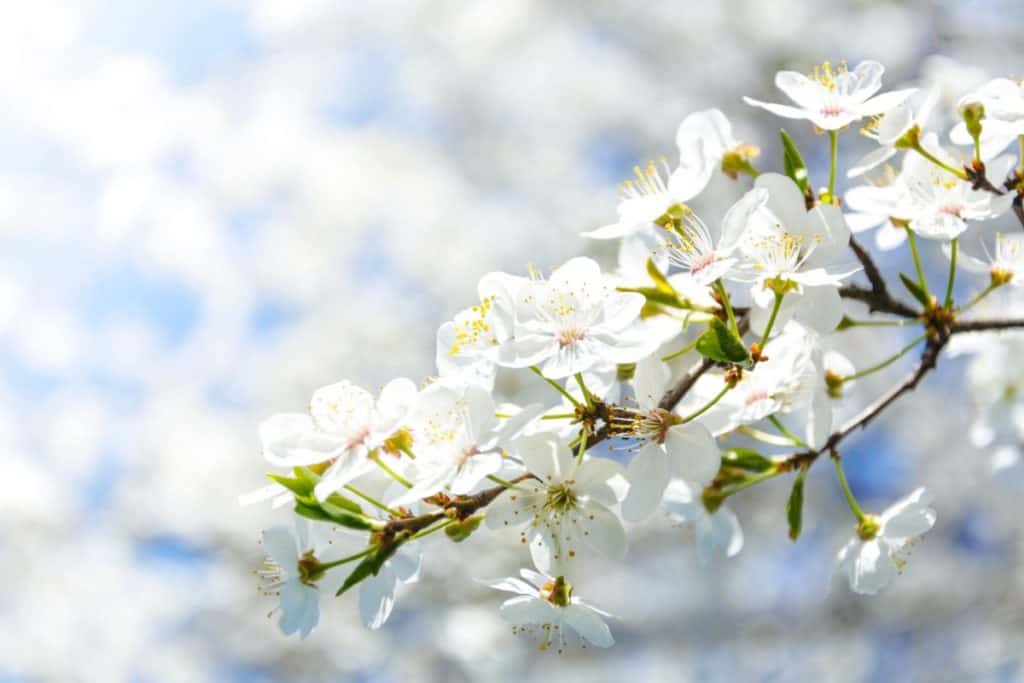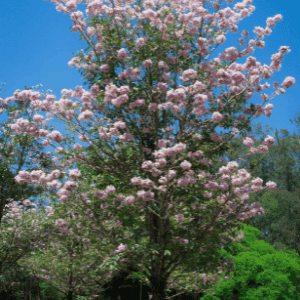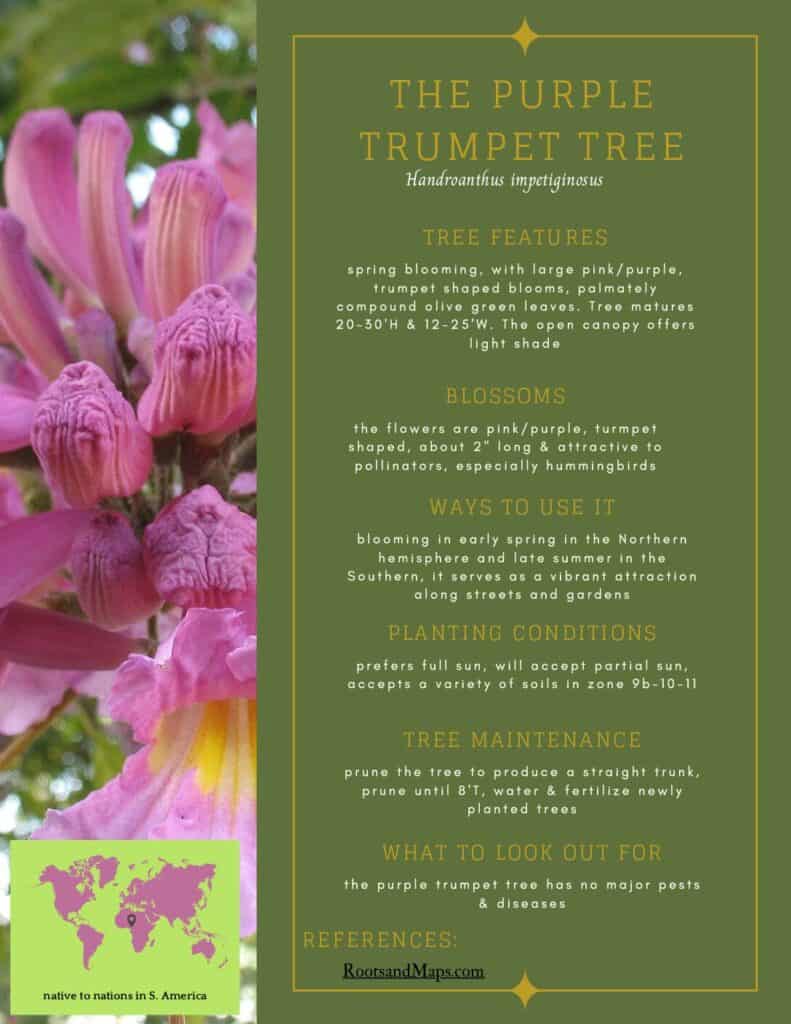Why Do We Love Flowering Trees?
This is the Purple Trumpet Tree-Handroanthus impetiginosus– pronounce it like this (hand-ro-anthus-im-pet-ih-jih-NO-suh). We appreciate this tree for its highly visible, showy purple/pink, trumpet-shaped flowers that appear in large clusters. A bonus is that these large blossom clusters get bigger as the tree matures in your garden.
This tree will mature between 15-20 feet in height and has an open canopy. You can plant under this tree as the open canopy will provide semi-sun for understory plants.
Note: this tree was formerly called Tabebuia but was reclassified in 2007. You may find some examples still being sold under the older name. There is more information with names below.
Why Our Fascination With Flowering Trees?
In the garden, the trees take the high road. They are at the top of the landscape. As the biggest and usually most permanent part of our environment are our most long-term investment and deserve our thoughtful attention.

We all love a flowering tree. Even in tropical climates, they are spring’s most awaited indication. In the temperate climates in which I grew up our symbol was white flowers, perhaps pink.
The purple trumpet tree is a tropical plant. Enjoy it on vacation or at your winter getaway.
About the Purple Trumpet Flowering Tree
This information should help you understand this ornamental tree and if it might work in your garden.
- About the tree-it’s important features
- How to use it
- How to plant it and care for it
- How you can attract wildlife
Purple Trumpet Tree-It’s Color

The vase-shaped flower of the purple trumpet tree ranges in color from purple to pink with a yellow throat. In tropical or near-tropical locales it’s all about the color. Tropical flowering trees come in many vivid colors. You have many choices.
For more flowering tree ideas for gardens in both temperate and tropical climates, use the flowering tree list.
While tropical climates offer plenty of vivid colors, most of our inbound population is coming from colder places. So much so, that efforts are underway to introduce some white flowering trees to Florida. As warm climate America grows rapidly with the incoming population from northern places, the white blossoms will feed a little of the newcomer’s nostalgia.
Foliage
The leaves of this trumpet tree are dark olive green and are palmately compound. This means that the leaf formation resembles the palm of your hand. The stems originate from a central point and fan-out from there. Look for 5-7 leaflets on each fan.
Shape And Size
If your available space is small this is a tree variety that can be trimmed every two years to control the size. If getting too big is an issue in your garden, this may be a useful tree for you.
The canopy is open providing light shade. The Purple Trumpet tree also called the lavender or even pink, trumpet tree will not provide deep shade. You will be able to plant under it and enhance the decorative appeal. Underplanting will add visual interest when the tree is not in bloom.
Location and Planting Zones
The purple trumpet tree is a tropical tree and performs best in zones 10 and 11. It is popular in southern and central California, Hawaii south Florida, and in some cases central Florida. (Hardiness zone 9) There are several color choices among trumpet flower trees and this purple variety is slightly more cold-hardy than others.
Location In Your Garden- The Root System
It appreciates full sun to partial sun, the root system is not considered invasive and it can be used near patios. Position it in a place with good drainage and it will accept a variety of soils.
*Plant dna testing has been ongoing for a number of years. When you see two different Genus and species names for the same plant that is what has happened. If you are concerned with getting the right tree, check the names with your County Extension service.
Important Things To Know
- Blue and purple shades are harder to find. This is particularly true in warm climates
- Purple trumpet trees are small to medium trees-they work in most gardens
- They are drought resistant and tend to be pest-free
- A number of garden needs can be fulfilled
- This tree blooms early, providing late winter color and you can plant other varieties of flowering trees to extend your spring season
- Adjustable to many growing conditions
- There are seed pods but the tree is not messy
The Color And Blossom-What Makes Them Special?
You can find pink, yellow, and white in other trumpet trees (the genera have over 100 members) there are some for you. The blossoms of the purple trumpet tree are remarkable, large, dramatic, long-lasting, and then there is the color! The blossom is in two shades of purple/ pink, light and dark. It has a distinctly blue undertone, hence the “purple” name. The throat of the big, trumpet-shaped blossom is blotched in yellow. You won’t forget the tree!
In South Florida’s warm climate many residents are seasonal. They miss much of our brilliant, later spring color. Our community loves its brilliant royal poinciana trees, but about half of the residents do not get to experience them in bloom. The Purple Trumpet tree blooms early enough so that we can all see them. If your Florida community is like ours this tree might be a good idea for you.
The flowers, interestingly, increase in size as the tree matures. It, also flowers at an early age.
Where Do They Come From
This tree is native to South and Central America, Mexico, and the West Indies, Most species are from Cuba and Hispaniola.
Wildlife And The Purple Trumpet Tree
Add this tree to your garden and you can expect to see hummingbirds, bees and valuable insects.
Ensuring You Buy The Tree You Want!
Gardeners know that understanding the correct tree name, Genus, and species will ensure that you get the tree you want when you buy one. With the actual name, you will also find the right information as to care.
Tabebuia impetiginosa was the original genus and species and Handroanthus impetiginosa* is the name today. It is a little frustrating to gardeners when the botanical names change. The change is due to our use of DNA research to identify plants, this change of names has been going on for some years now and fortunately is slowing down as DNA testing gets completed.
If you read articles describing the Tabebuia impetiginosa, they were simply written before scientists changed the name. Don’t worry it’s the same tree!
Other Similar Trees-Get The One You Want
If you are ready to buy a tree, note that this tree category is one in which it is important to be very specific in stating what you want;
- The purple trumpet tree is Handroanthus impetiginosa– the blooms should be purple/pink or blue/purple. Be specific about your requirements.
- The Cuban pink trumpet tree is tabebuia pallida– its flower is pale pink to white, and the tree can reach 40′ tall. Depending on your location this can be an unpleasant surprise in a few years!
- The pink trumpet tree is Tabebuia heteraphylla– it is similar in size to the purple trumpet tree but the color is much different!
Why Did This Tree’s Name Change?
We always placed this beauty in the genus Tabebuia, a name far more fun to say than Handroanthus! However, some research done in 2007 found that not all of the trumpet flowering trees we called Tabebuia (because they looked similar) really had common ancestors. So more research changed the genus.
If you want more detail read this brief article from the University of Florida. “Trumpet Trees”. If this is the tree you want, ask for Handroanthus impetiginosa!
How To Use The Purple Trumpet Tree
Purple Trumpet tree is desirable as a specimen tree, it provides light filtered shade, you can plant under it, You can use it as an accent for a flower bed, in a wide lawn, a parking island, to mark a property line, and create an archway for driveways and walkways. It is an excellent small tree near a patio for a little shade.
Note: I did read one criticism of the Purple Tagebuia as a specimen tree. Because the canopy is open it is suggested that it be used to accent a planting bed or to have some plantings under it for added interest. Because it does have a deciduous period, I think this is a valid criticism. Sometimes in the year, it needs a little enhancement;
Fair enough?
Features Of The Tree
Size And Shape
Fairly slow growing, the purple trumpet tree will remain small to medium in height and width. It has an irregular and open silhouette. For appearance and health, the trunk is trimmed when young to produce a single trunk. Continue annual shaping until the tree reaches about 8′ tall.
The Tree is semi-evergreen, dropping its leaves for a short period before blooming. The bare period is shortest in the warmest climates.
Hardiness Zones
This tree will do well in the warmer sections of Zone 9b and in zones 10 and 11. Popular in Florida, California, and Hawaii, It will regrow from a minor freeze.
How To Plant It
Dig a hole two times the width of the tree’s root ball and as deep as the ball. When planting a group of these trees, plant 12′-20′ apart. Place the tree in the hole and water the rootball before refilling the hole. Ensure that the roots are on solid soil, allow no airspace underground. Allow the trunk flare (where the trunk joins the root) to be visible. After planting water in deeply and use a root-promoting fertilizer.
When To Plant
In the warm climates where this tree grows plant either in late winter or early spring. The tree will require generous amounts of water; as it is growing its roots and the tree above ground at the same time. You can also plant in the fall, after the heat has ended, at this time the young tree will only be involved in creating strong roots. Avoid if you can, as you would in any climate, planting in the extreme seasons of heat or cold.
Light Requirements
Full sun is preferred. The tree will accept some partial shade.
Soil Preferences
The Purple Trumpet tree is adaptable to a variety of conditions, Good drainage is needed and if you can amend your soil it does remarkably well in rich soil. It will live in a range of soils but it does relish soil that is improved with organic matter.
Soil drainage is important, consider amending the soil with organic material to improve drainage. This is especially true in clay-like soil.
How Do I Know If My Soil Drains Well?
This post on Flowering Dogwood shows how to test your soil for drainage.
Food and Water
Fertilize young trees in spring before the new growth begins. Provide a light application of 16-4-8 fertilizer. Water deeply and continue for the duration of the growing season. Mature trees, after year 3, should not require fertilizer.
Water-New plantings, for the tree’s first two weeks, water twice per week. Then decrease the water to one per week but increase the amount of water offered. This will encourage deep root growth. At the end of the year, you should be watering every two weeks. After this, the tree should only occasionally require water during dry periods.
Pruning
The tree should be pruned to achieve a single trunk and staked until it reaches 8′ tall. At this point, they can be allowed natural growth.
Pests and Diseases
The purple trumpet tree has no major pests or diseases.
Resources
This is a research-based report on The purple trumpet tree.
Here are more flowering trees. This report is split into temperate and tropical climate trees.

